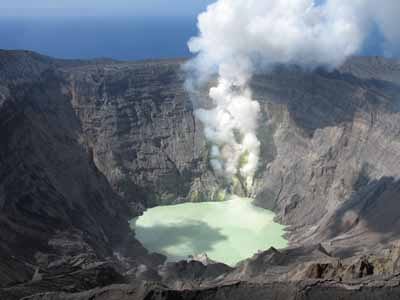A chain of 14, breathtaking Pacific islands is paradise lost without reliable electricity.
The Northern Mariana Islands, a U.S. commonwealth some 1,500 miles east of the Philippines, has seen its garment industry waste away in the face of global competition. Attracting replacement industry is difficult, in part because of the commonwealth’s undependable power supply. Rolling blackouts are the norm, caused by aging power plant equipment and the irregular delivery of expensive, imported diesel to run the plants.
SMU’s geothermal energy team of faculty and graduate students is aiming to prevent the Islands’ economic oblivion by helping to convert their volcanic heat into affordable, renewable energy.
“This [energy crisis] could be the United States 20 years from now,” says James E. Quick, associate vice president for research and dean of graduate studies at SMU.
Quick knows from his own work in the Marianas what it would mean for residents to cut their dependence on costly diesel fuel. He directed a volcano-monitoring program for the islands during his previous career with the U.S. Geological Survey.
Most recently Quick has served as a liaison for the island government in its search for renewable energy: He introduced Northern Mariana officials to SMU’s recognized experts in geothermal energy: David Blackwell, W.B. Hamilton Professor of Geophysics in Dedman College, and Maria Richards, coordinator of SMU’s Geothermal Lab.
In the Marianas, the SMU team is studying the potential applications for two different types of geo-thermal systems that use Earth-heated water and steam to drive turbines and produce electricity.
Testing has been completed on volcanic Pagan Island, where the results are being studied to determine if a large, steam-driven power plant like those found in California and Iceland may be a fit.
On Saipan, the most populated island in the Marianas chain, subsurface water temperatures are lower because there is no active volcano. Testing of existing water wells completed in early summer supports the potential for building smaller power plants designed for lower temperatures. Plans call for drilling a test bore hole on Saipan to confirm water temperatures at deeper depths.
Interest in geothermal energy has been growing against a backdrop of rising oil prices.
Google.org is providing nearly $500,000 to SMU’s Geothermal Lab for improved mapping of U.S. geothermal resources. Blackwell, who has been collecting heat flow data for 40 years, is credited with drawing attention to the untapped potential energy source with his Geothermal Map of North America, first published in 2004.
The Google.org investment in updating that map will allow Blackwell to more thoroughly mark locations where potential exists for geothermal development.
Blackwell and Richards are convinced that oilfields may be some of the most overlooked sites for geothermal power production in the United States. SMU’s geothermal team is offering an energy solution that would boost capacity in low-producing oilfields by using the deep shafts drilled for petroleum products to also tap kilowatt-generating hot water and steam.
The process of pumping oil and gas to the surface frequently brings up a large amount of hot wastewater that the industry treats as a nuisance. Install a binary pump at the well head to capture that waste hot water, Blackwell says, and enough geothermal energy can be produced to run the well, mitigating production costs for low-volume wells. It can even make abandoned wells economically feasible again.
Taken a step further, surplus electricity generated from an oilfield full of geothermal pumps could be distributed to outside users at a profit. This kind of double dipping makes sense for short and long-term energy production, Richards says.
“This is an opportunity,” she says, “for the energy industry to think outside the box.” — Kim Cobb
Related links:
SMU geothermal home
SMU Geothermal Lab
SMU geothermal program
Google invests in SMU geothermal research
Google video: Advanced geothermal technology![]()
CBN News: Geothermal energy right under our feet
Texas geothermal energy
David Blackwell
James E. Quick
SMU Roy M. Huffington Department of Earth Sciences
Dedman College of Humanities and Sciences
 A chain of 14,
A chain of 14, 
